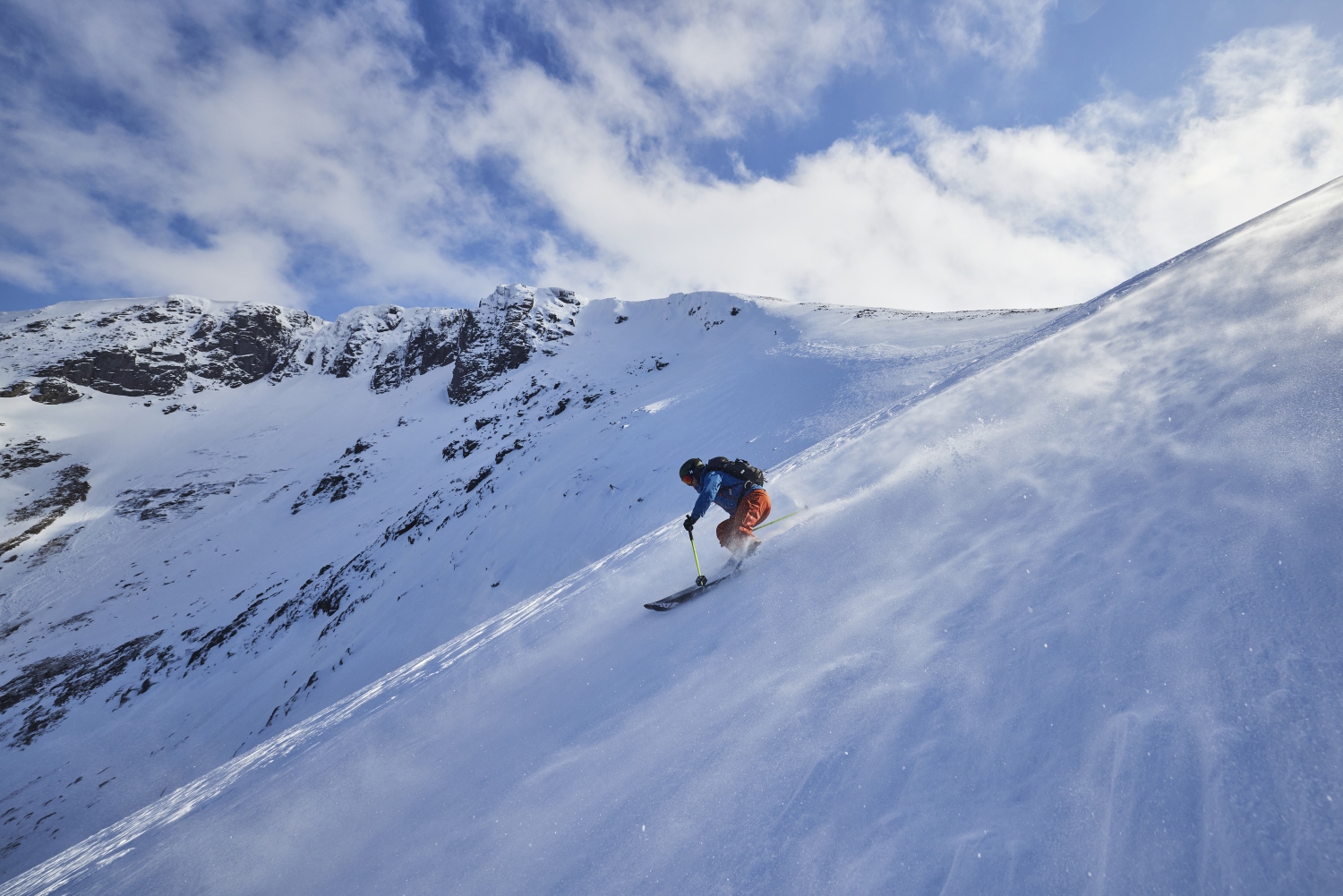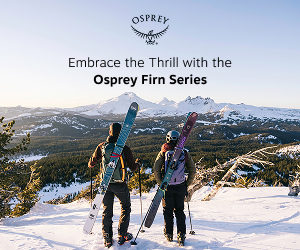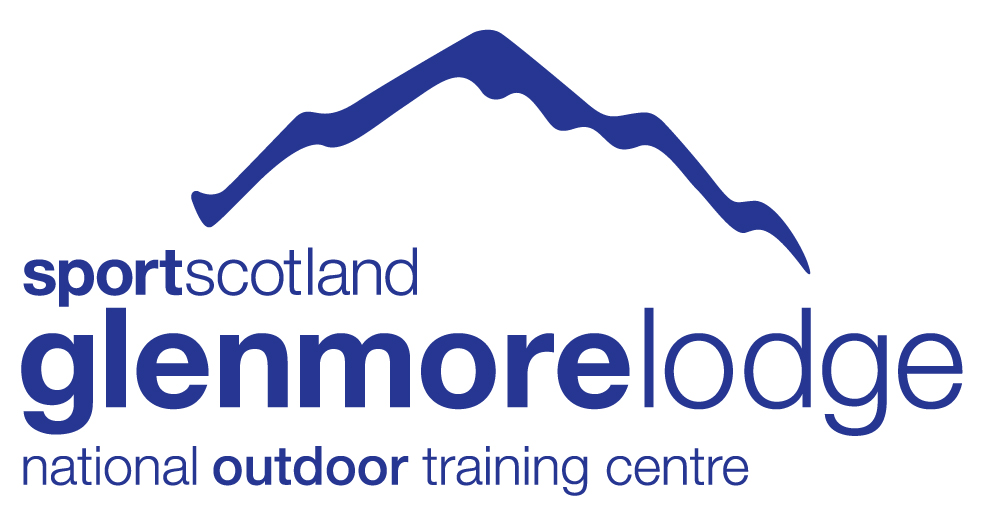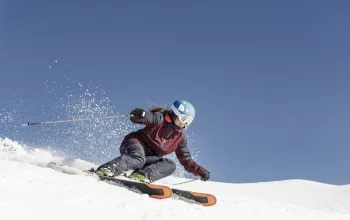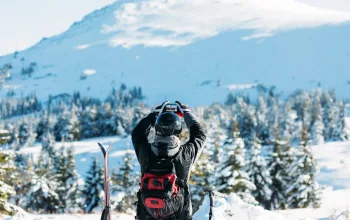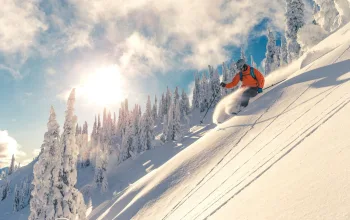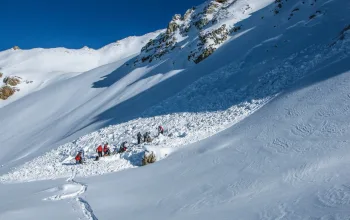Sponsored content
Ski touring, a discipline which involves using specialised climbing skins that let you ski uphill, has exploded in popularity in recent years, and with good reason. Unlike alpine skiers (who rely on lifts) or cross country skiers (who need largely flat tracks) ski tourers can pretty much travel wherever they want.
Because of the element of physical exercise involved, ski touring appeals to all kinds of outdoorsy people, from hardcore endurance athletes to those who just like getting out into nature. The mental health benefits of outdoor exercise are well documented, and ski touring is a great way to keep up your cardiovascular fitness through the cold winter months.
Of course, for skiers who love powder (and what experienced skier doesn't?) the advantages are obvious: ski touring lets you access fresh snow that others can't reach. Whereas most off-piste skiers are limited by what they can traverse to from the lift (or how far they're willing to hike in deep snow) ski tourers can head off into vast, trackless areas of backcountry beyond ski area boundaries. Learn a few more technical ski mountaineering skills and entire mountain ranges open up, with limitless possibilities.
The discipline had a huge boost during the pandemic as many European countries closed their ski lifts. But even before Covid struck, ski touring equipment was the fastest selling category of ski gear according to the industry research body SIA.
While the UK can't realistically compete with the Alps when it comes to ski resorts, Scotland is a great place to try ski touring. Scotland's lift systems are small, meaning that much of the best skiing in places like the Cairngorms National Park can only be accessed using touring gear.
At the same time, the mountains are a manageable size, so you won't be faced with Eiger-style north faces right from the off (although there's plenty of gnarly skiing in Scotland if you know where to look). Taking a train to Scotland is also way better for the planet than flying to the Alps, and one of the main benefits of ski touring is its reduced environmental impact, especially when compared to other ways of accessing the backcountry like heliskiing or cat skiing.
We've teamed up with Andy Townsend, Head of Snowsports at the Scottish National Outdoor Training Centre at Glenmore Lodge, to talk you through the basics of this fast-growing discipline—and share our top tips to help you start ski touring yourself.
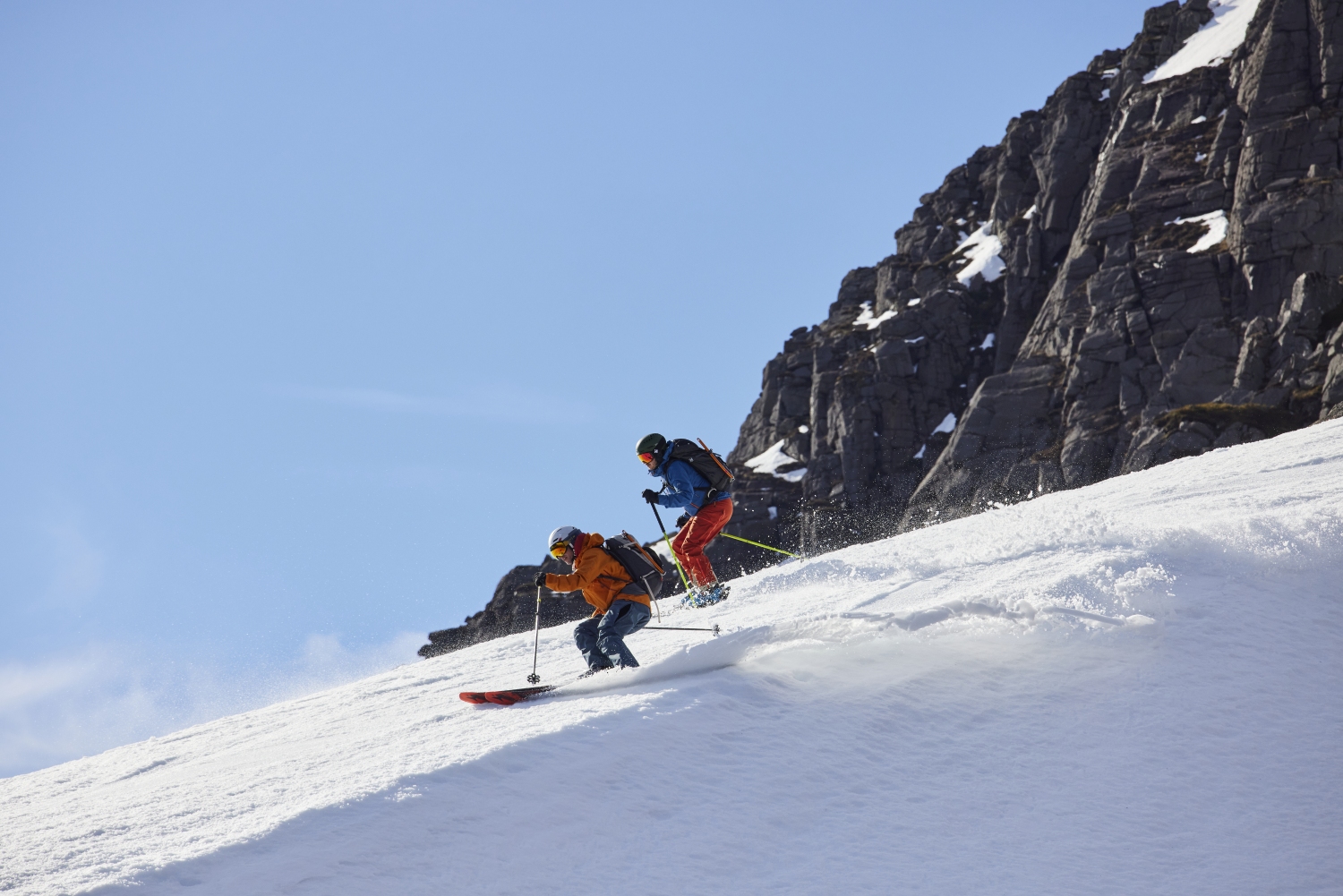
Don't be intimidated
Getting started with ski touring can feel like a scary prospect, even for those with plenty of off piste skiing experience. Heading deeper into the backcountry requires careful preparation and planning, as well as a well-honed skill set. But none of it is rocket science.
The good news is that if you're a proficient skier already, you've done the hardest part. As Andy Townsend says, "the trickiest and most time-consuming part of ski touring to master is the actual skiing bit!" We wouldn't recommend trying ski touring until you're an accomplished piste and off piste skier. But from a technical point of view, the uphill bit of ski touring is very easy. It just requires a reasonable level of fitness.
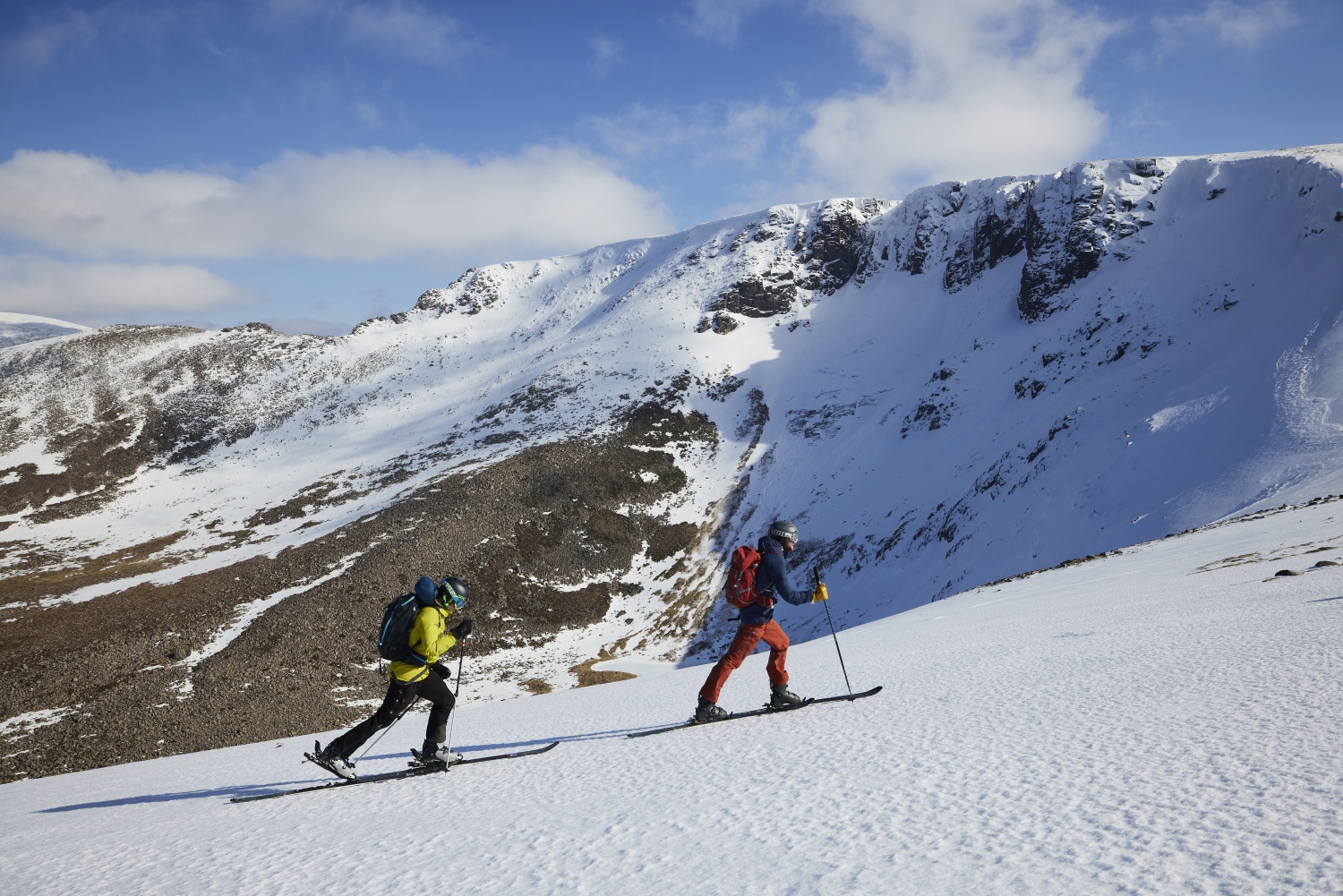
Do be careful
Ski touring might be technically easy, but venturing into the backcountry, far from groomed slopes, and the watchful eye of ski patrol, will always carry inherent risks. Avalanche safety is an essential part of ski touring. But there are also more basic precautions you'll need to take, like you would if you were going hiking in Scotland in summer.
Packing adequate food, water and a first aid kit. Making sure your group's navigation skills are on up to scratch, and making sure everyone has enough clothing to stay warm if the weather changes—these aren't things that alpine skiers normally have to think about. They can usually nip into a mountain restaurant to eat or warm up, and consult a piste map if they get lost. As a ski tourer, you're on your own.
These days, some resorts have dedicated ski touring parks—areas that are controlled for avalanches, patrolled by pisteurs, and usually close to the pistes, to help those on their first ski tour get to grips with the basics. But there are still risks involved that far outweigh those you'd encounter with regular alpine skiing. As Andy Townsend says, "with ski touring, there is both a lot to learn and a lot to practice."
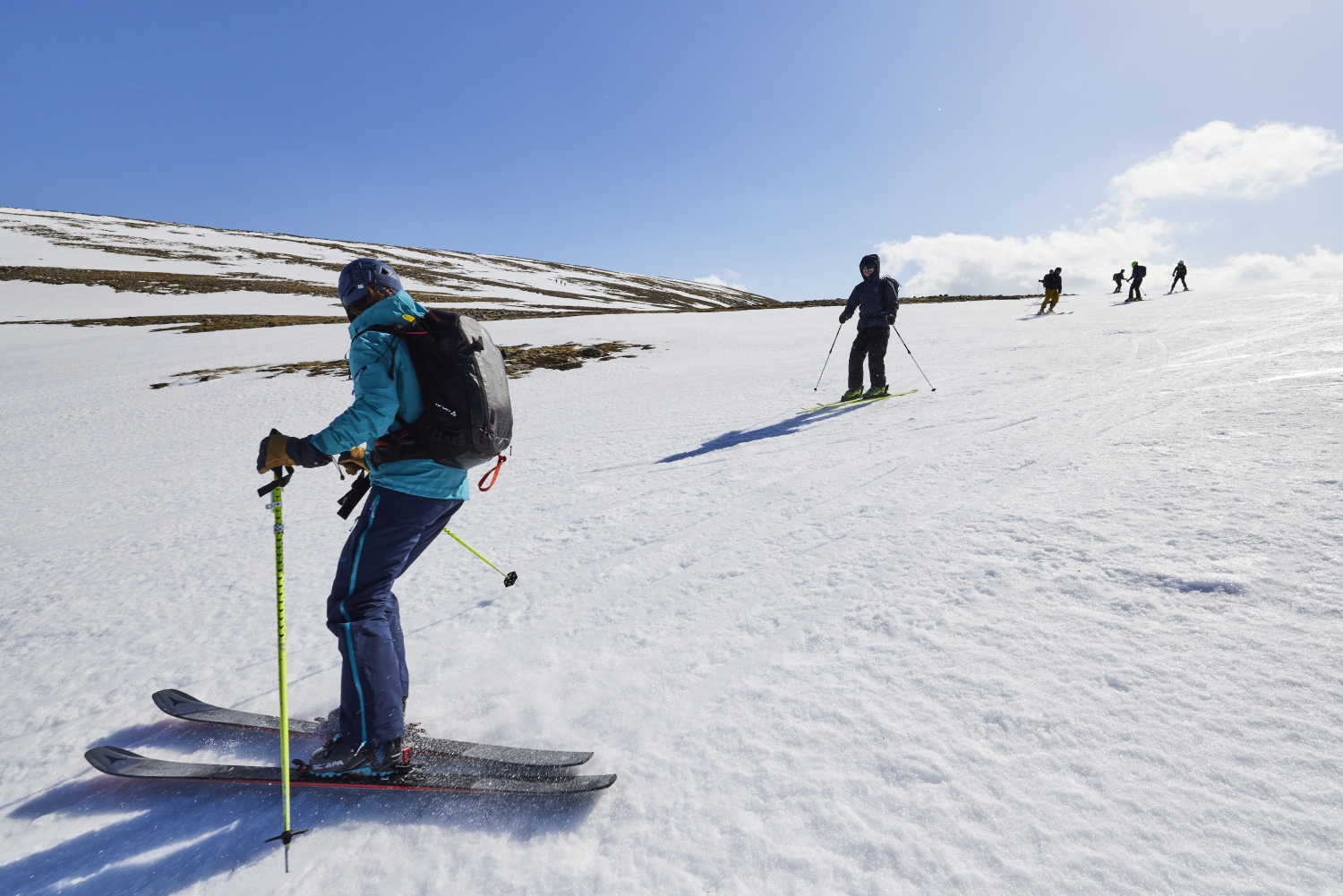
Go with a guide
Unsurprisingly, the best way to learn ski touring skills is from an expert like Andy. Which is why we suggest one unbreakable golden rule for first time ski tourers: always go with a guide. "Having someone hold your hand and share their knowledge while you head into the backcountry for the first time is invaluable," says Townsend. Glenmore Lodge offers a whole range of backcountry skiing courses, which include ski touring for beginners.
Taking a course brings countless advantages. For starters, it will make your first ski tour infinitely safer. Guides will have know the terrain, local snow conditions and so on, and will be able to make the all important judgement calls about where it's OK to go. Guides also remove the stress of route and tour planning, and can help you avoid basic mistakes, like carrying too much heavy kit for the conditions. They will help you with technique while skinning uphill, and give you tips your downhill performance. But most of all, a guide will make your first ski tour way more fun.
A guide with local knowledge will almost certainly be able to choose more manageable routes for the climbs, and find you better snow on the descents. In a mountain range like the Cairngorms, knowing where to find pockets of powder can really make the difference to your first ski tours. Even highly experienced ski tourers usually hire guides, so if you're in a group of ski touring beginners, it's a must.
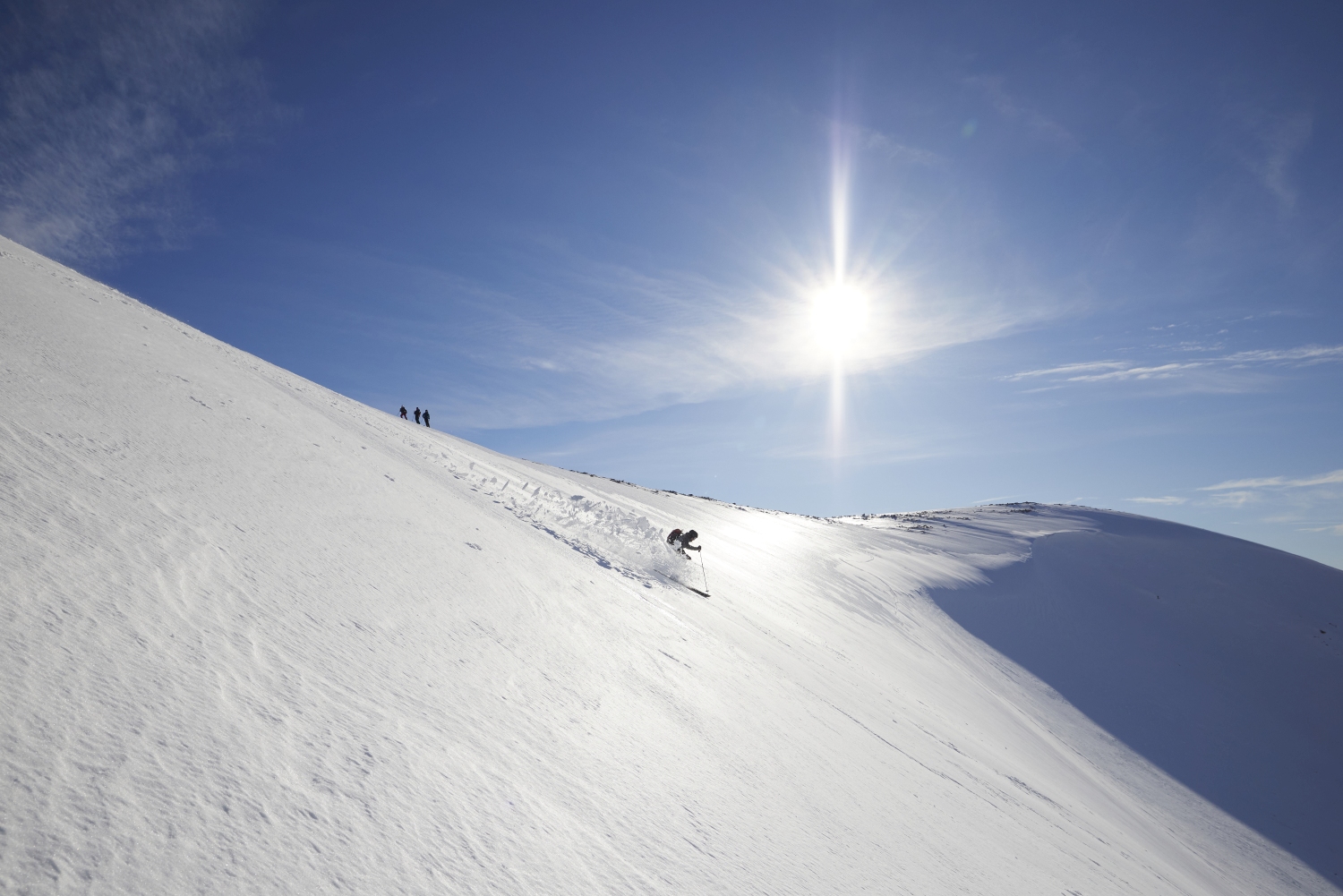
Learn your essential avalanche safety skills
It's a guide's job to take decisions about safety, line choice, which climbs are doable given group fitness levels and so on. But a guide can't be solely responsible for the safety of a group. Anyone who's venturing into the backcountry needs to take responsibility for themselves, and know how to use their avalanche safety equipment.
The key here, Andy Townsend says, is not to view your avalanche transceiver, shovel, and probe as a form of protection. "These items are essential and everyone in your party should have them and know how to use them," he says. "But it is important that you remember they are rescue equipment not safety. You are only going to use them to rescue a companion, once you or a member of the party has been avalanched, after making a poor decision."
The difference is more than just semantic—it's making good decisions that will keep your group safe on the mountain, not your beeper, avalanche probe, shovel, or airbag. Learning how to make good decisions comes, of course, with experience—which is one reason why hiring a guide is essential—but the basics of good, safe, decision making can also be taught. "Attending an avalanche course with your regular ski partners is a really good way to ensure no one in your group is working to a different and potentially dangerous agenda," says Andy.
At Glenmore Lodge, he and his colleagues teach a range of avalanche courses, and because of the variable weather, the Cairngorms are a great place to practise safety skills too.
Mountaineers sometimes joke that "the Himalayas are good training for Scotland". But there's an element of truth in the idea that learning in Scottish conditions will prepare you well for other mountain ranges around the world.
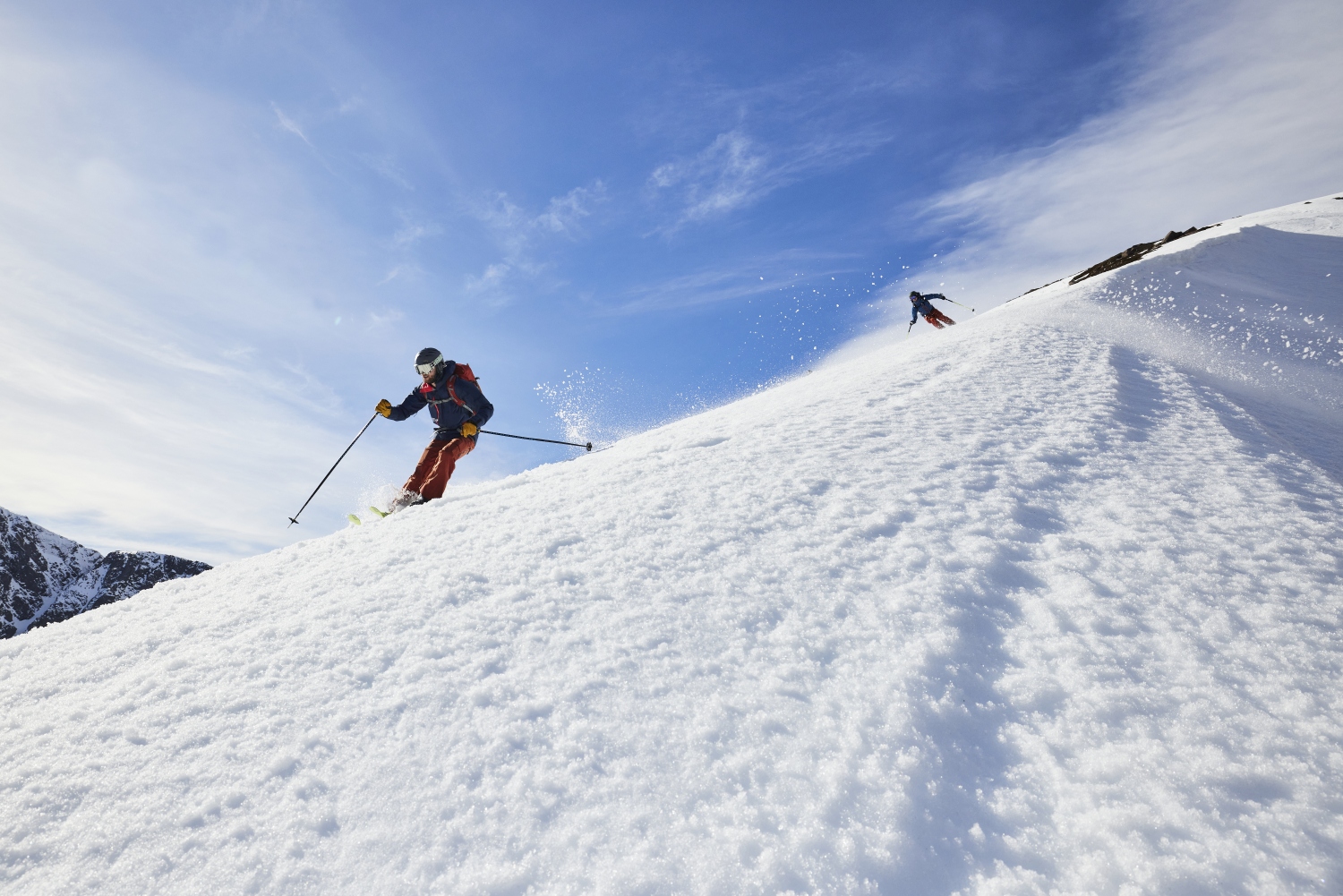
Make sure you have the right ski touring skillset
"A ski tourer needs a very broad ski skill base before considering venturing into the backcountry," according to Andy Townsend. And as with safety skills, Scotland's often variable conditions make it a great place to learn these.
There are two basic elements to a ski touring adventure — the way up, and the way down. Depending on your background, you may need to spend more time thinking about one or the other. As Andy Townsend says: "A proficient downhill skier with some experience of off piste snow will find the uphill part of the journey the most challenging and the descent the most enjoyable, while the mountaineer/hill walker venturing out on skis will find the uphill straightforward, but will find the downhill to be challenging, exhausting and potentially very dangerous until they master their skis."
As we mentioned earlier climbing uphill, the skill that a proficient skier will need to spend time working on, is technically relatively easy. The basic movement involves shuffling your skis forward one at a time, and zig zagging your way up the slope. The tricky part is the kick turn — the movement you need to execute when you reach the end of a zig zag and have to turn around. But if you start off practising on a gentle route with an easy slope incline, under the watchful eye of a good guide, you'll nail it pretty quickly.
After that, it's just a question of cardiovascular fitness. Ski touring is a little like going for a slow jog, and while efficient technique can help you expend less effort, there's no getting away from the fact that if you struggle to run 5km, you'll probably struggle climbing a powdery slope.
As Andy suggests, those who come from a hill-walking background might be able to breeze through the climb uphill, but they face a trickier challenge in mastering the discipline of ski touring overall. You don't have to be a pro to try it, by any means. On gentle slopes in good conditions, even a strong intermediate skier can have fun ski touring. But as Andy Townsend explains: "Snow can vary from turn to turn, and it is vital that the skier can cope autonomously with anything the mountain throws at you.
"The energy wasted through poor technique and endless crashes is not the only concern. Being able to control your speed and turn exactly where you want to will allow you to avoid obstacles and hazards, which is especially important when you are far from immediate medical help." Townsend recommends spending lots of time perfecting your backcountry skiing technique in the 'sidecountry' (the terrain between groomed slopes, and around lifts) before trying ski touring proper.
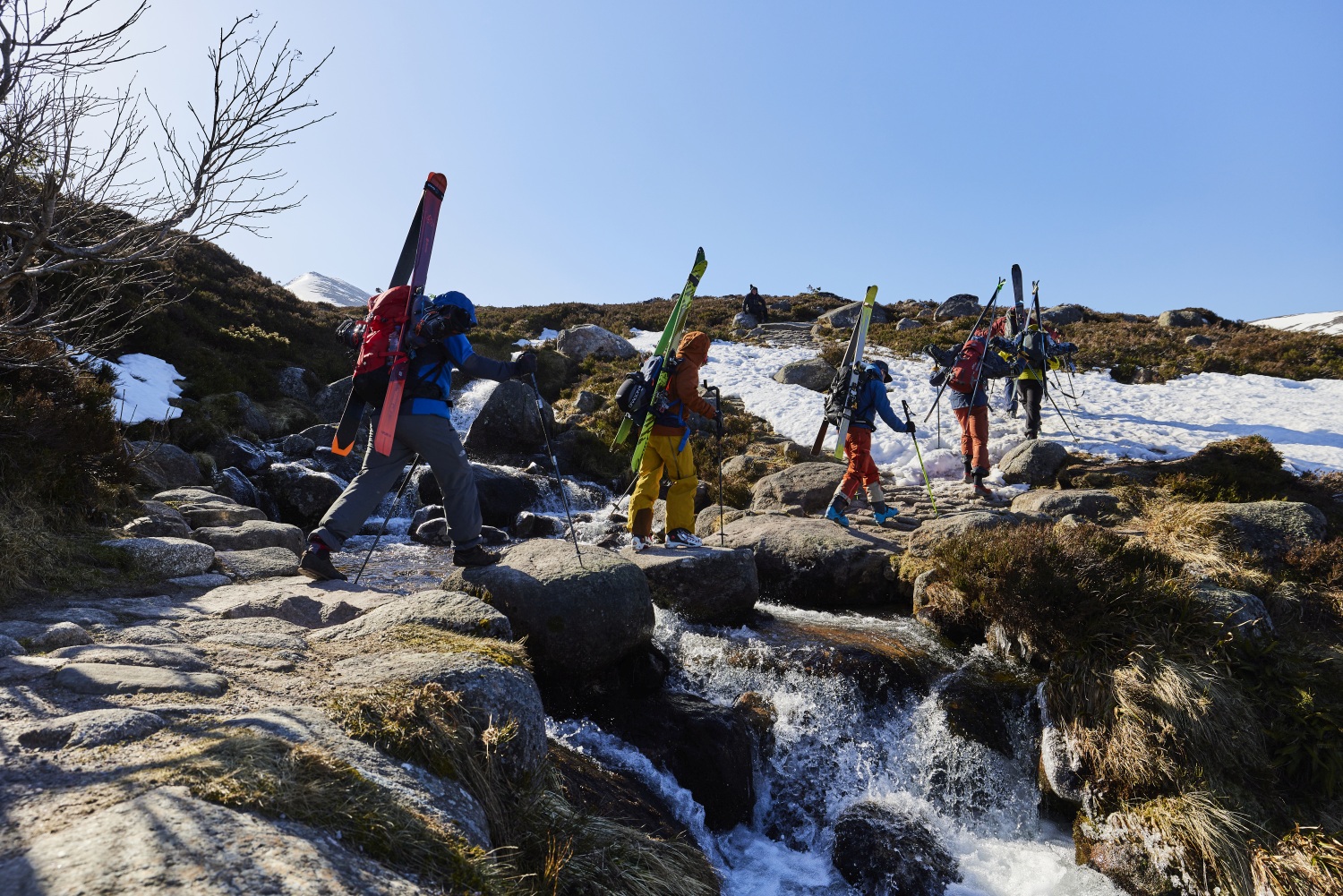
Make sure you have the right gear
We've put gear at the end of this list because we believe that ski touring beginners should take everything else into consideration before they think about what ski touring equipment they need. The phrase "all the gear, no idea," (or its more earthy equivalent, "all the clobber, still a nobber") is common parlance in ski resorts. But while having kit that you don't know how to use might make you look silly within the resort boundaries, in the backcountry, it can be deadly.
So, before you buy any of this specialist equipment, make sure you've done your homework, perfected your skiing skills and (ideally) signed up to a ski touring course. Many places that offer ski touring for beginners will be able to rent you ski touring gear for your first tour. but you may find that you want to invest in things like ski touring boots at an early stage. Here are the ski touring gear essentials.
Touring skis
Dedicated ski touring skis are quite specialist compared to regular alpine skis. They are almost always lighter, with manufacturers often compromising things like torsional stiffness to save weight. This usually means they perform less well on piste or hard-pack, but you'll appreciate the reduced weight when you're climbing uphill on the skin track.
Today's touring skis range from massive, fat beasts with waist widths of 120mm plus, to skinny whippet-like planks with less than 80mm underfoot. Wide skis float more in powder, and so tend to be better for the descents, especially in deep powder. But that extra width makes them heavier, which is why some ski tourers—often Italians with a penchant for lycra one-pieces, road cycling shades, and climbing helmets—prefer short, skinny skis. They might not be great on the downs but if you're racing uphill, you can absolutely motor.
Ski touring bindings
The crucial difference between ski touring bindings and regular ski bindings is that you have to be able to lift your heel up as you climb, to shunt the ski forward, as you would in cross country skiing. Unlike cross country skiing, you then have to be able to lock it down again for the descents.
Companies have experimented with different types of touring bindings over the years, but these days most people prefer pin bindings, which are far lighter. There are some frame bindings (ie. classic alpine downhill style bindings) with heel lift settings that work. If you're a part time tourer these can be a good option, not least because they'll save you from having to buy a pair of pin compatible ski boots just for touring.
Ski touring boots
Dedicated ski touring boots differ from traditional alpine boots in three main ways. Firstly, like all ski touring kit, they tend to be lightweight. This can mean they're more expensive, as materials like carbon fibre are substituted for plastic to keep the weight down.
Second, touring boots usually have a flexible cuff, with a walk mode that makes it easier to slide your skis forward when touring uphill. (They also have a locked in downhill mode for descending, of course).
And third, touring ski boots usually have holes in the sides of the toes to make them compatible with pin style touring bindings. Holes aside, the toes look a lot like those on any other ski boot, and they're usually compatible with normal frame bindings too.
Ski touring poles
Ski touring poles aren't all that different from regular ski poles, except that they tend to be lighter, and they're usually telescopic, with a clasp mechanism of some sort that can lock them at different lengths.
As a ski tourer, you often find that you'll want your poles shorter on steep climbs and longer when you're using them to push yourself along flats. If you're on a ski tour which involves traversing a particularly steep slope, it can sometimes be useful to set one pole shorter than the other for balance.
Ski touring skins
Climbing skins, or ski touring skins, as they're also known, are an essential part of ski touring equipment. The early versions used by the sports' pioneers were literally made of animal skin, which was laid along the ski with the fur facing the rear. This meant you could shuffle the ski one way, but the fur would grip on the snow, stopping it sliding backwards—the essential innovation that made ski touring possible.
The original skins were permanently nailed on, but that made sliding downhill trickier. Today's skins are made of synthetic fur, with sticky glue on the other side, so you can peel them off when you need to descend. They usually have tail clips, to ensure they're stretched tight over the whole body length of the ski.
Avalanche transceiver, shovel and probe
These are the three essential bits of rescue kit you should buy as soon as you start venturing into the backcountry—whether that's to ski tour, or simply ride powder off the side of the lifts.
The avalanche transceiver, or beeper, sends out a signal so that if you get buried beneath the snow, others in your group with avalanche transceivers set to "search" mode can find you. The probe, a collapsible pole usually made of carbon or aluminium, allows them to fine tune their search once they've picked up your signal. The shovel—which should be light enough and pack down small enough to fit in your pack—lets them dig you out.
Places like Glenmore Lodge which teach ski touring for beginners will usually rent out beepers, shovels and probes. But as you ski tour more, This is kit you need to know like the back of your hand, so you can use it quickly in case of emergency.
Ski touring backpack
A ski touring backpack needs to be lightweight and waterproof enough to handle heavy snow, as well as large enough to carry skins, shovel, probe, extra layers, and all the other bits of kit you need for ski touring.
Crucially, it also has to be comfortable when fully laden, as you'll be spending long days on the skin track wearing it, and it shouldn't move around too much when you're coming down the mountain at speed. A decent padded waistband is a must, as is a chest strap.
These days, many ski touring backpacks have avalanche airbag systems in them. The way these work is best explained by filling a cup with a mixture of sand, stones and gravel, and giving it a good shake. You'll notice the larger objects rise to the top. If you're being carried down the hill by an avalanche, inflating the airbag makes you a larger object, which means you're more likely to end up at the top of the slide when the snow sets.
An avalanche airbag system isn't as essential as the other rescue kit, which you should never go into the backcountry without. But while it's not part of the basic gear you need on all your ski tours, it can definitely help improve your chances of survival in the event of an emergency.
To find out even more about ski touring in Scotland, go to glenmorelodge.org.uk.
- READ NEXT: Best Touring Skis


